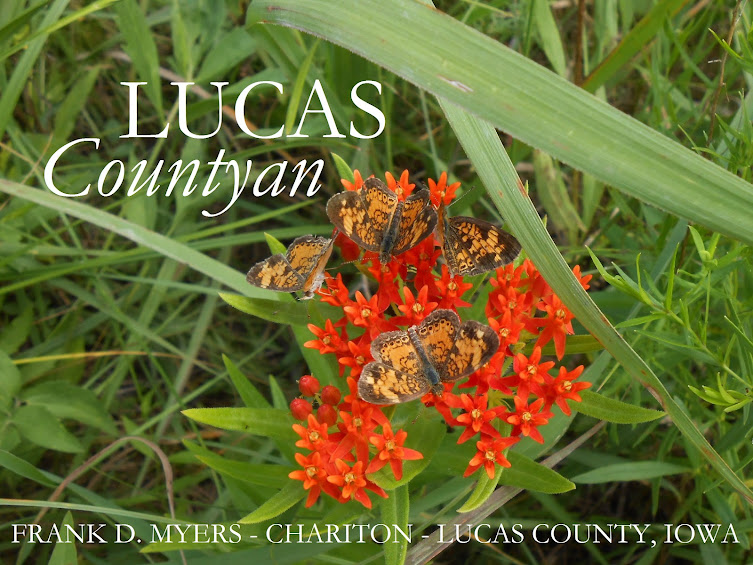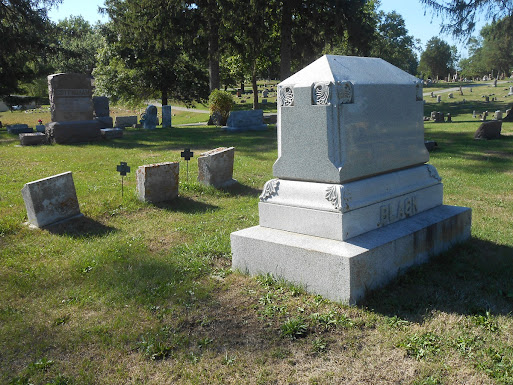I wrote last week about the Hass family desk and its move from one place to another on the Lucas County Historical Society Museum campus (The Hass desk gives up one of its secrets). At the same time, we moved this item, too, an Edison dictaphone that so far as I know had stood in a corner of the Stephens House front parlor since it was donated by Raymond and Carolyn Pim during 1969.
At the time, the Stephens House was the only building on the museum campus. As more buildings and display areas were added, the dictaphone, for some reason, never was moved to a more appropriate setting. But it is a piece of office-related equipment, so it made sense now to pair it with the desk, which also began life in an office, and display the two pieces together in a new setting.
After the move, I decided to check out its backstory and discovered, in looking at the original deed of gift, that it had belonged to Raymond Pim's aunt, Miss Luleen Thompson, who was a professional stenographer at a time when professional women were the exception rather than the rule. She died in Osceola during 1915 and is buried with her mother in Bethel Chapel Cemetery in far northeast Clarke County, not far from the Lucas County line.
Sadly, her end was a tragic one --- as told in a front-page story in The Osceola Sentinel of May 6, 1915 --- but that's part of the record, too. Here's the story:
+++
One of the most distressing events that has occurred in the city of Osceola in many months took place at the home of Mrs. Sarah Thompson in the southeast portion of the city Saturday afternoon when her daughter, Miss Luleen Thompson, took her own life with a revolver.
The story of the tragedy including the events that led up to it briefly told are as follows. Some months ago the deceased, a lady 35 years of age, having completed a course of stenography under the direction of Court Reporter Wm. Hyland resigned her situation with the Iowa Telephone Company and accepted a position as stenographer with the First National Bank at Lexington, Nebraska.
Her health having failed her, she returned home during the early part of the winter and with the exception of a few weeks stenographic work in Des Moines remained at home with her mother until the final day.
During the early part of last week she applied to the authorities for permission as required by law to purchase and carry concealed weapons, giving as the reason the fact that she and her mother lived alone and that they might feel more secure with a revolver about the house. So frankly and light heartedly did she make the application that there seemed no good reason for not granting her request.
With the authority granted, she went to Paul's hardware and purchased a Herrington-Richard self action 22 cal. rim fire revolver with which her life was ended a few days later.
In so far as the reporter could learn nothing unusual occurred in the young lady's conduct about her home until Saturday afternoon when her mother returned about 1 o'clock from her usual hour's shopping trip up town and found the daughter in the downstairs bedroom sitting upright in a rocking chair apparently dead. In response to the alarm that was given, Chas. Stahl, a next door neighbor, entered the room and found Luleen Thompson dead with the above described revolver lying by her side still clutched in her right hand.
The following note written with a typewriter and signed with pen and ink was found in the room:
To Whom it May Concern ---
This is my voluntary act and deed. There is absolutely no one to blame for it in any shape or manner. Bury me at Bethel and I want to be embalmed, also use my own clothes for I abhor shrouds. (signed) Luleen Thompson
In response to the alarm that was given, Dr. Hollenbeck arrived immediately and soon Sheriff Tillotson accompany by Justice W.E. Morrow, acting coroner, to take the body officially in charge. An examination revealed that the bullet had passed directly through the heart. There was very little indication of an external wound. It was the judgment of the officers that no inquest was required.
Funeral services were conducted at the residence by Rev. J.D. Duling of Garden Grove at 9 o'clock on Tuesday morning after which the body was laid to rest in Bethel cemetery.
Luleen Thompson grew to womanhood in Clarke county and she has a wide and favorable acquaintance in Osceola and surrounding community. She was a bright and attractive young lady and a member of a highly respected and well-to-do family. The sympathy of a host of friends goes out to the grief stricken mother and sisters. The obituary is given below.
Luleen Thompson, daughter of Lorenzo and Sarah Thompson, was born near Nevada, Iowa, December 6th, 1879.
She moved with her parents to Liberty township (Clarke County) where they resided on a farm until the spring of '97 when death claimed the father. The mother then in company with the daughters came to Osceola to reside. She attended school for a time, then accepted a position in the telephone office which she filled with credit for many years. It was said in her seven years service she was never a minute late, ready and willing at all times to do all her strength would permit and many times went beyond her strength. After severing her connection here she accepted a position in the First National Bank at Lexington, Nebr. After several months of faithful service her health began to fail and she gave up her work and came home.
Luleen was one whom only those who knew her best could understand. In her quiet way she went about ever trying to lighten the burdens of others with little thought of self. One must know her to understand and love her. And even now as we look into her sweet face we cannot understand it is the last deep sleep.
There is left to mourn a heartbroken mother and three sisters, the father and a brother having gpreceded her in death many years ago. The sisters are Mrs. Frank Pim of Lucas, Iowa; Mrs. Hue Watson of Dayton, Wyoming; and Mrs. Dan Thurlow of Le Roy Iowa.
The funeral service was held from the home at 9 o'clock Tuesday morning. Rev. J.D. Dulling of Garden Grove, assisted by Rev. W.C. Cole of this city, conducting the service.
 |
| Find a Grave photo |






















































